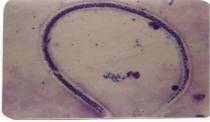
Caused by infection with major nematode parasite Wuchereria bancrofti and Brugia malayi, lymphatic filariasis continues to be the major cause of clinical morbidity in tropical and subtropical countries.

Elephantiasis Hydrocele
Though it is never directly fatal, it is a debilitating disease with acute and occult forms of the disease causing severe physical suffering and the chronic form resulting in disfigurement. The psychosocial problems and reduced economic output makes it a major socio-economic impediment in the affected population.

W.bancrofti
micro fialria
The precise diagnosis of filariasis is presently based on the
demonstration of parasites in night blood. The parasitological examination of
night blood however is inconvenient and not sensitive
Sevafilachek (IgG & Ag assay), dipstick based enzyme immunoassays have been
developed at this institute using penicillinase enzyme, microfilarial antigen
and filarial antibodies to detect active filarial infection in different
clinical groups. The test systems show a sensitivity and specificity of about
80%. They are also found to be useful for immunomonitoring of clinical filarial
cases to determine the optimal period of DEC (OpDEC) therapy for clinical relief
and cure. The tests are particularly useful in the effective management of acute
and atypical manifestations like minimal hydrocele, epididymo-orchitis,
lymphangitis, lymphandenitis, pain and swelling in limbs and joints in adults
and asthmatic bronchitis, pulmonary eosinophilia, monoarthritis and recurrent
URI in children.
An anti-filarial vaccine will be an effective additional adjunct in the
integrated control of this infection. We have identified three purified B.
malayi filarial antigens i.e., a 120 kDa BmA2 (from adult worms) and 45 kDa ESF-5 and 200
kDa SF-1 from microfilaria as protective immunogens based on their high
reactivity with ‘putatively immune’ endemic normals and confirmed their
ability to induce protective immunity using jird as filarial animal model. While
BmA2 and ESF-5 were found to have potential as vaccine candidates for immuno-prophylaxis,
SF-1 was found to be helpful in blocking filaria transmission in community.
1)
SEVAFILACHEK based
IgG and antigen assay systems have been found to be useful
for detecting filariasis using day blood samples.
2)
Some imported kits ICT and Trop
bio kits are useful in detecting carriers but not filaria disease cases.
3) SEVAFILACHEK
in addition to detecting carriers has been found to be useful in confirming
filaria aetiology in acute, chronic and occult filarial infected cases in adults
and children coming to the hospital with clinical problems.
4) Prototype
SEVAFILACHEK kits are being used and found useful in management of filarial
patients at Calicut, Bilaspur, Rourkela, Hosur, Bubaneswar and Chennai.
5)Filter paper blood samples are routinely received from different places namely Allepi, Thiruvannanthapuram, Coimbatore, Periyar, Vellore, Cuddapah, Vijaywada, Hyderabad, Chandrapur, Lucknow, Sultanpur, Bhopal, Jabalpur, Aligarh and Delhi for filarial diagnosis.